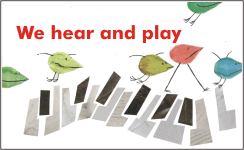
Click to return to the home page
Absolute pitch can be generally described as "the ability to recognize pitches without relative references." However, there are different levels of this ability.
1. Absolute hearing of a specific pitch
Many musicians can hear one certain pitch absolutely. This sound is usually a middle C, although it is sometimes middle D or A.
2. Absolute hearing of multiple pitches
This is an expansion of level 1, although the pitches differ from person to person. Sometimes only C is recognized, but in many different octaves. Other people may recognize only middle C and G, or perhaps C, D, G, and A.
3. Absolute hearing of C-major pitches in narrow range
Many people can recognize a small range of C-major piano sounds (the white keys). They may, for example, recognize all the white notes between G and C, predominantly in the middle octave. The upper and lower ranges vary from person to person at this level.
4. Absolute hearing of all C-major pitches
At this level all C-major piano sounds can be recognized-- all the white keys, but not necessarily the black keys.
5. Absolute hearing of all pitches in limited range
At this level all pitches in a certain area can be identified; for example, between low C and high C. The boundary between the pitches which are and are not absolutely recognized is not always distinct.
6. Condition-contingent absolute hearing
In this variant of absolute hearing, listeners from any of the previous levels can apply their ability only when in a good physical and mental state. Consequently, there are people who, in unfavorable conditions, can recognize only one or two absolute sounds, but in good conditions can recognize a larger number.
7. Timbre-contingent absolute hearing
Sometimes, pitches can only be recognized on one type of instrument-- and sometimes only on one specific instrument. Any of the previous levels can appear in different combinations: for example, a person may be able to identify only the sounds of a certain piano in unfavorable conditions, while under good conditions that same person can recognize sounds from any piano or other instrument.
8. Absolute hearing connected with musical production
Many people can internalize a musical piece and hear it especially well in memory. Its beginning, or a precise section of it, can strongly impress a pitch or key-signature sensation upon them. This ability is typically also condition-contingent. Additionally, many people can identify pitches based on the boundary of their singing voice, or by focusing their voice on a specific pitch. The examples in this category, however, all concern a relative sequence of sounds based on an imaginary reference sound. This category does not truly belong to our definition of absolute pitch.
9. Complete absolute hearing
This level supercedes all previous ones. It is the ability to hear, irrespective of conditions, all musical sounds of any instrument as well as the human voice. Compared to this level, the others can described as "incomplete" absolute pitch.
10. Active complete absolute hearing
People with complete absolute hearing can imagine pitch sounds in their mind, and they can recreate those sounds by singing them. We call this "active absolute pitch." We Hear and Play strives for this level of absolute hearing as its principal goal.
Most people with this active ability also recognize pitches from any source. Sometimes, however, a person may have this active ability but also have incomplete absolute pitch. Children who are developing absolute pitch by means of We Hear and Play will pass through several of the levels before they achieve complete active absolute pitch.
Preface by Christopher Aruffo
Foreword by Naoyuki and Ruth Taneda
Frequently Asked Questions about Absolute Pitch
Introducing Traditional Notation, part 1